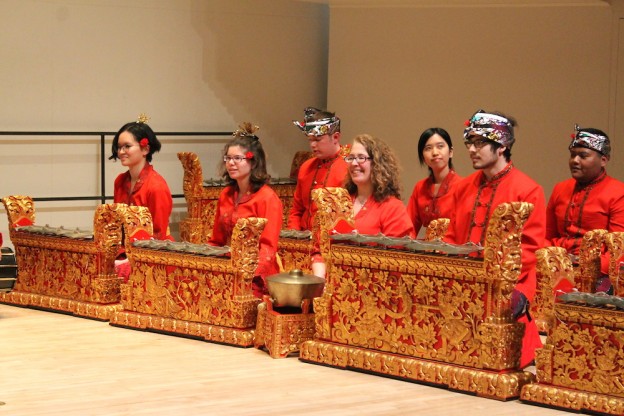On Sunday, April 14 at 3pm, Gamelan Semara Santi will perform in Lang Concert Hall. The event is free and open to the public.
Gamelan is the traditional ensemble music of Java and Bali in Indonesia, and is made up of primarily percussive instruments. Gamelan does not use notation, and is instead memorized by members of each ensemble. Written music does exist, but only serves to preserve specific pieces. The tempo is controlled by a hand-played drum called kendhang, while other musicians play a variety of traditional Indonesian xylophones, metallophones, flutes, and gongs, as well as several bowed and plucked instruments.
Central to Gamelan music is the idea of collectivity and community; there are no solos, and while musicians do rehearse in individual sessions, emphasis is placed on group participation. Professor Tom Whitman, who co-directs the Gamelan Semara Santi along with I Nyoman Suadin and Ni Luh Kadek Kusuma Dewi, says that community is one of the things that makes Gamelan so special: “I think it creates a real sense of bond that most of us really treasure.” He says that he’s observed something that he, somewhat jokingly, calls “Gamelan ESP:” “If I’ve got four people, and not one of them could play through a pattern by themselves, when they sit down together, they transmit it to each other and somehow they’re able to do it.” Gamelan, he says, allows people to do things in a group that they couldn’t do as individuals.
Gamelan instruments carry immense significance. Most of the keyed instruments are made of bronze which, Professor Whitman says, is considered very spiritually powerful. In Indonesian culture, bronze is said to retain the spirits of every person who has owned it. “I tell them they’re joining a community of people that has been playing the same instruments for more than twenty years. I sort of feel like everyone that’s been a part of it, stays with it.”
Another important aspect of Gamelan music is the dancing that goes along with it. Professor Whitman says that one of the things he likes to tell his students is that, “to do Balinese Gamelan without also doing dance is like performing Beethoven’s 9th Symphony without the chorus – you kind of miss the point.” The upcoming performance will feature both musicians and dancers, all of whom will be dressed in traditional costumes.
Gamelan Semara Santi is made up mostly of Swarthmore students, but other community members have become involved as well. When asked about what one can expect from the upcoming concert, he says:“Beautiful, shimmering, bell-like sounds, great costumes, and a lot of stylistic variety. There’s a tremendously varied musical culture there [in Bali], and every one of the pieces we play sounds remarkable different from all the others.”
Gabriel Hearn-Desautels ’20
